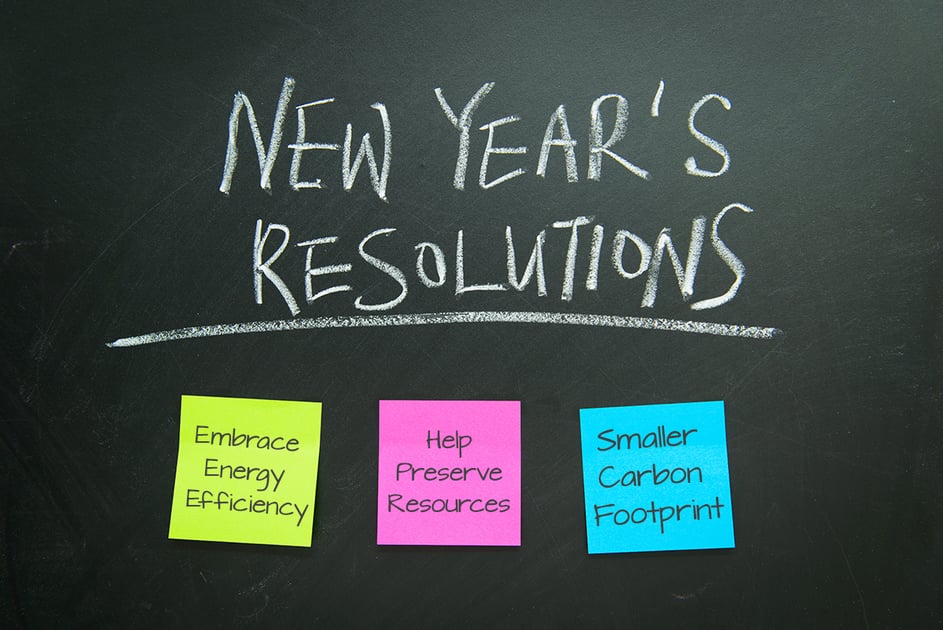New Year’s Resolutions: Embracing Energy Efficiency
January 2, 2025 •Dr. Julie Sessions, Curriculum Consultant

As we usher in a new year, it's the perfect time for students to think about resolutions that not only improve their lives but also have a positive impact on the environment. With growing concerns around climate change and energy consumption, encouraging students to adopt energy-efficient practices at home is a practical and impactful resolution. Before diving into resolutions, though, it's important to ensure students understand what energy efficiency means and why it matters.
In simple terms, energy efficiency is about using less energy to perform the same task. It can decrease greenhouse gas emissions, help combat climate change, lead to lower utility bills, and preserve resources for future generations.
Once your students grasp these concepts, you can discuss resolutions. Here are some ideas to inspire your students to be champions of energy efficiency.

Resolutions for the Classroom or at Home
Conduct an Energy Audit: Have you ever analyzed the energy used in your classroom or home? Complete an energy audit where students can observe, analyze, and make a plan for energy use both in the classroom, school, and at home.
Switch to LED Light Bulbs: Make sure all light bulbs in the school and at home meet the U.S. Department of Energy’s minimum standard of 45 lumens; LED bulbs meet these requirements. Use this activity in your classroom to learn more about LED bulbs.
Unplug Electronics When Not in Use: Many electronics consume energy even when turned off. Unplugging chargers and devices when not in use prevents this "phantom" energy waste. Check out this Phantom Energy Scavenger Hunt for students to do in school or at home.
Use Power Strips: Utilizing power strips for electronics easily turns off multiple devices at once. Here are two activities your students can complete to explore power strip use: Power Strip Overload and Comparing Power Strips.
Set Your Thermostat Wisely: Adjusting thermostats in the classroom and at home can conserve energy and cut costs. Students can compare temperatures in rooms around the school and even interview facilities personnel to talk about the electric bills. Students can ask parents to show them the home electric bill and talk about how setting the thermostat wisely can help conserve energy and save money.
Embrace Natural Light: Open curtains or blinds during the day to embrace natural light. This allows sunlight to produce heat instead of artificial lighting. A good activity to do with students is to put a thermometer on a counter and record the temperature the sun heats it to through a window. Students can also create a schedule when the sun will be in different locations to best utilize natural light.
Use Energy-Efficient Appliances: In this activity, Energy Audit, students gauge how much power various appliances use. They check the labels or manuals of appliances to find its power rating, usually in watts (W), and record how many hours per day each appliance is used to determine usage time. This is a great activity to do in school and at home.
Close Doors: Closing front and back doors is an easy resolution that can help save energy. Students can take it a step further and investigate door sweeps by completing these two activities: Comparing Door Sweep Models and Engineering a Custom Door Sweep.
Turn Off Lights: Develop the habit of switching off lights every time you leave a room. This simple act can significantly reduce electricity consumption and lower energy bills. Have students look at electric bills to help them understand how much energy is consumed monthly in their homes or in schools. Here is a fun investigation to explore LED light bulbs: Light Bulb Investigation: Exploring Efficiency of LED Light Bulbs.
Monitor Water Use: Using products such as aerators can help reduce water use. Here are some fun activities for students to explore aerators:
- DIY Faucet Aerator
- Faucet Aerator with Engineering Designs
- Creating a Digital Showerhead Aerator with Microcontroller
Use Cold Water: Washing clothes in cold water helps save money and energy used to heat the water. Use a digital thermometer to monitor the water temperature. Here are some fun activities to do with your students with digital thermometers: Measuring Temperatures with a Digital Thermometer and How Insulation Affects Temperature.
Change Filters: Setting a date on the calendar to change filters is a great idea for anyone! This makes the air quality the best possible and helps the machines run at maximum efficiency. Here are some activities you can do with your students to explore air filters: Checking Air Quality Without Filters and Building and Redesigning Your Own Air Filter.
Setting New Year's resolutions focused on energy efficiency is a proactive approach to fostering environmental responsibility and sustainability. These resolutions encourage students and their families to adopt habits that reduce energy consumption, leading to lower utility bills, a smaller carbon footprint, and conserved resources for future generations. Additionally, these resolutions promote awareness and education about the importance of sustainable living, inspiring broader community involvement. Committing to energy efficiency for the New Year is a meaningful step towards a more sustainable and eco-friendlier lifestyle.
